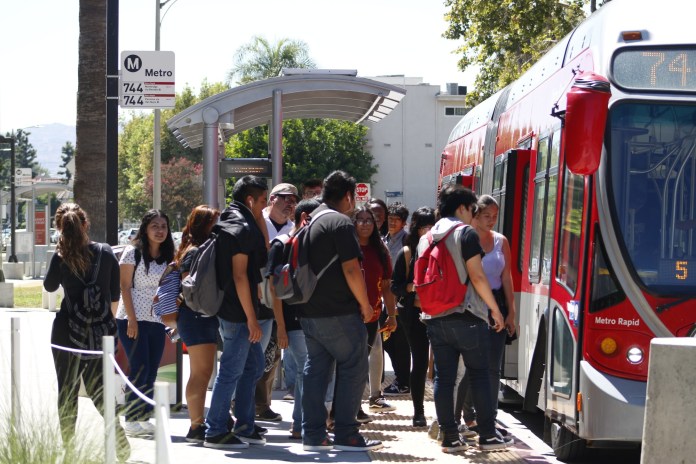On March 29, 2017, I published a letter to the editor pushing for a public takeover towards the CSUN Dorm to school and Metrolink shuttle. Now I will start proposing a solution to this issue. In this follow-up, I would like to address some of the broad service and bus fleet proposals.
As I mentioned in my first piece, these bus services are currently run by a private French firm called Keolis. I feel the profit incentive of being privately owned, caps the true service potential of the CSUN tram.
For example, the tram’s service stops early on Friday, and doesn’t run at all on Saturday, despite the fact that CSUN has Saturday classes. In addition, it currently runs every 10 to 15 minutes from 7 a.m. to 10 p.m. Monday through Thursday, and every 10 to 15 minutes from 7 a.m. to 4:30 p.m. on Friday. There is no service on Saturday, Sunday and holidays.
To compare, I’ve looked at Metro’s timetables on Metro.net, and most routes run all seven days including the Metro 240 and 744 lines that service CSUN. These routes run the most frequent on weekdays. However, these buses still run on reduced schedules on Saturday, Sunday and holidays.
For my proposed CSUN tram schedule, the busiest and most frequent hours would still be Monday through Thursday, but there can be reduced schedules on the less busy days such as Friday and Saturday. From Monday to Thursday, the 10 to 15 schedule would still apply. On Friday however, I propose having service every 10 to 15 minutes from 7 a.m. to 6 p.m. On Saturday, the least busy day, I propose a 20 to 30 minutes schedule from 7 a.m. to 6 p.m.
The reason to keep the tram running until 6 p.m. is due to the University Student Union computer lab and CSUN library closing at 5 p.m. on Fridays and Saturdays.
Having the buses run until 6 p.m. will give people the ability to go back to the dorms and dorm parking lots, if they stay until these utilities close. On Sunday and during holidays, there will be no service since campus is closed, apart from the dorms and Student Recreation Center. Moroever, all of the current tram stops need to be clearly marked with signposts along with a visible map and timetable attached to it, like most public transit bus stops.
In the case of Metrolink buses, they also need to run more frequently and not just at peak times in peak directions like they currently do. Looking at the Metrolink schedule for the Northridge station, the train times are spaced far apart except for the time block between 8 a.m. to 9 a.m.
All trains usually run Monday through Friday without any weekend service. Having those trams run more frequently to connect to every Metrolink Northridge Station train would also encourage more use of the public transit system, and can be considered as a way to ease parking problems on campus.
The bus fleet size I envision is around four 25 feet buses for the dorm tram route, and two 30 feet buses for the Metrolink bus shuttle. This small fleet size means it is probably best to stick with one bus maker so there can be fleet standardization. Most bus fleets in L.A., including Metro, run almost entirely on natural gas and commonly compressed natural gas (CNG), as it is significantly less polluting than gasoline, especially diesel. In addition, it is probably one of the main reasons why L.A.’s air quality has significantly improved over the past few decades. Using gasoline such as diesel for CSUN’s bus fleet will look extremely bad on the campuses strong environmental track record, and the area in general.
However, it is important to note that these measures, with the mandatory investment into a bus yard with a CNG filling station, along with the ADA compliance, will most likely bump up the price tag for these type of buses.






